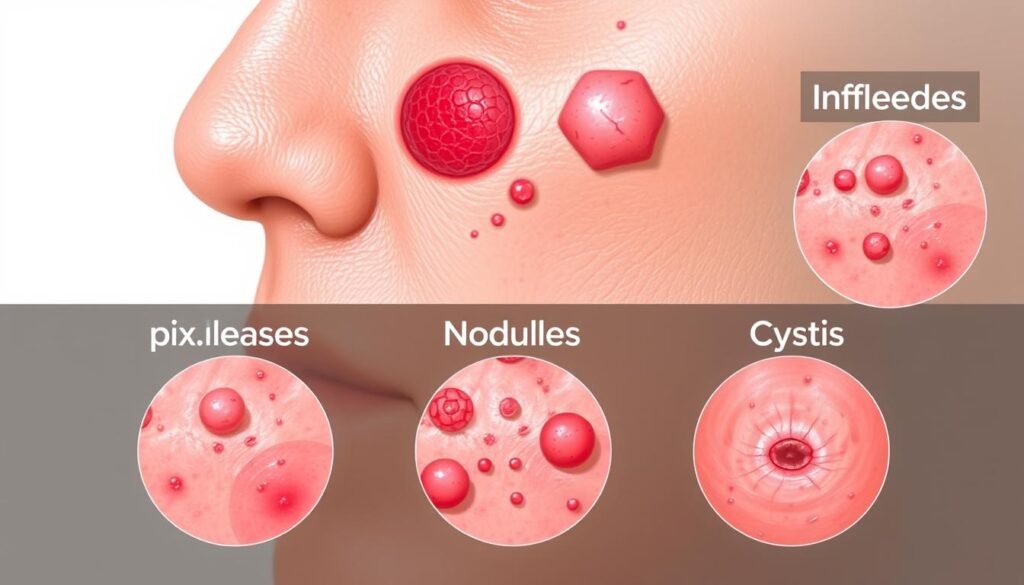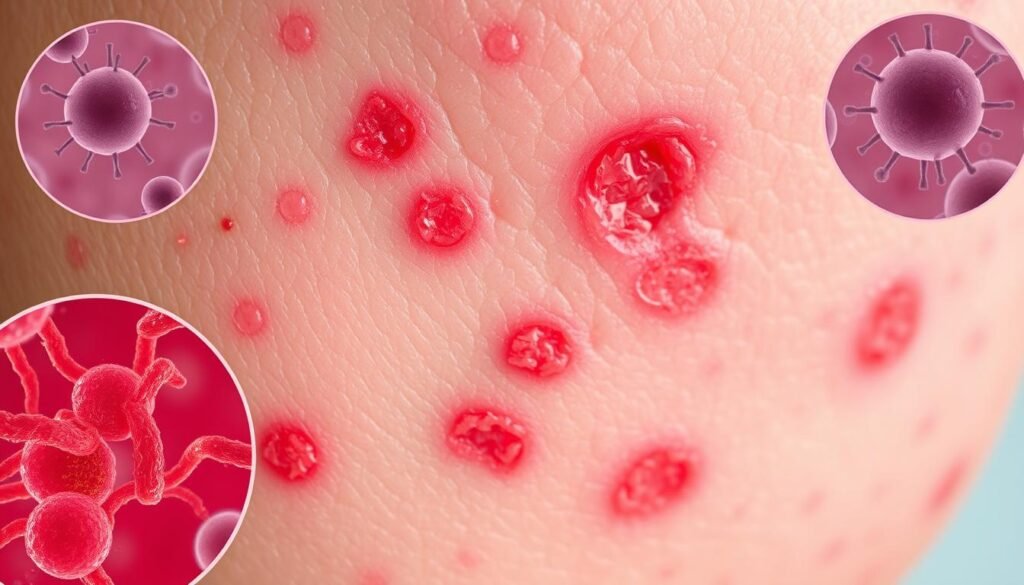Did you know acne affects nearly 80% of young people? In the United States, about 5 million people see a doctor for it every year. That costs over $2 billion. This skin problem can make people feel bad about how they look. It can also hurt their feelings and make them feel down. Almost everyone might face it during their teen years. So, knowing how to deal with Acne-Induced Inflammation is very important.
Acne is not just about looking different. It’s a serious condition that makes skin red, swollen, and painful. This issue can lower anyone’s self-confidence. Understanding the types, symptoms, and reasons for acne is key. This knowledge helps in finding the right way to treat it.
Key Takeaways
- Acne vulgaris affects around 80% of adolescents and young adults.
- 5 million doctor visits for acne occur annually in the U.S., costing over $2 billion.
- Acne serves as a significant psychological burden, leading to increased risks of self-injury.
- Understanding acne as a chronic inflammatory condition is essential for effective management.
- Physical manifestations include painful, swollen blemishes that require proper treatment.
What is Acne-Induced Inflammation?
Acne-Induced Inflammation is the body’s way of reacting to certain types of acne. It causes painful, swollen spots on the skin. These can be papules, pustules, or cysts. The problem starts when clogged pores get infected, leading to redness and pain.
The immune system fights back against this infection. It targets bacteria and other problem-causing elements. This battle leads to the red, swollen spots of inflammatory acne.
The skin makes natural oils through its sebaceous glands. Sometimes, there’s too much oil. It mixes with dead skin and blocks the pores. This blockage is a perfect place for bacteria, especially Cutibacterium acnes, to grow. Their growth kicks off the immune response, making inflammation worse.
Preventing and treating this kind of acne needs routine skin care and lifestyle changes. It’s key to cleanse regularly. Using products with benzoyl peroxide or salicylic acid is helpful. Staying hydrated is also important. These steps help control the oil and reduce acne risk.
For more treatments for this acne type, click here.
Types of Inflammatory Acne
Knowing about different types of inflammatory acne helps in treating it well. This acne can harm our skin health and how we feel about ourselves. Main kinds are papules, pustules, nodules, and cystic acne.
Papules look like small, red bumps on the skin. They might hurt when touched but do not have pus. Pustules, on the other hand, are full of pus and appear white or yellow. They are often inflamed and can scar if left untreated.
Nodules are big, hard bumps under the skin, causing a lot of pain. They are deeper than cysts because of clogged and inflamed pores. This makes the skin change color and is tough to treat. Cystic acne is the worst, with big, painful pus-filled cysts that can leave big scars. It needs strong treatment.

Knowing the differences between acne types helps in getting the right treatment. For light acne, creams might work, but bad acne needs stronger medicine and a doctor’s care. Quick treatment helps in managing it well.
| Type of Inflammatory Acne | Characteristics | Potential for Scarring |
|---|---|---|
| Papules | Small red bumps, painful but not filled with pus | Low |
| Pustules | Red, inflamed lesions filled with pus | Moderate |
| Nodules | Large, firm, painful bumps beneath the skin | High |
| Cystic Acne | Deep, painful cysts filled with pus | Very High |
Understanding these acne types shows why it’s important to care for our skin the right way. This includes choosing treatments that fit our specific needs.
Symptoms of Acne-Induced Inflammation
It’s important to know the signs of acne-induced inflammation to manage it well. You might see redness, swelling, and soreness where it hurts. There can be small red pimples or big, deep cysts on the face, neck, chest, or back. This can cause a lot of discomfort, pushing people to get help.
Inflamed acne looks different from one person to another. You might see small red bumps called papules or pus-filled spots known as pustules. Then, there are the more painful nodules and cysts, causing more intense pain and bigger inflamed areas. Each kind affects how someone feels about their acne outbreaks, often hurting both physically and emotionally.
Acne doesn’t just change how skin looks; it can hurt someone’s feelings about themselves. Constant outbreaks can make someone feel really bad, leading to stress or feeling down. This is why treating visible signs of acne is as important as dealing with what causes it. Finding the right treatment is key.
Causes Behind Acne Redness and Inflammation
Acne redness and inflammation come from complex factors. It’s key to know what causes acne to manage it well.
Role of Excess Sebum
Too much sebum is a big reason for acne. It clogs pores and lets bacteria grow, causing red and inflamed skin. Learning to control sebum with good skincare can help keep skin clear.
Impact of Hormonal Changes
Hormones, especially during puberty, can make acne worse by making more oil. Treating the hormonal causes of acne might reduce inflammation and make you feel better.

Stress, diet, and the environment can also make acne worse. Handling acne well means focusing on both sebum and hormones. Knowing these details helps in finding the right treatment for better skin. For details on acne and inflammation, check out this resource.
| Factor | Effect on Acne |
|---|---|
| Excess Sebum | Clogs pores, promotes bacteria growth |
| Hormonal Changes | Increases oil production, triggers inflammatory responses |
| Diet | Certain foods may worsen inflammation |
| Stress | Can lead to hormonal imbalance and acne flare-ups |
Pathophysiology of Acne Vulgaris Inflammation
Acne develops through several biological factors, each adding to the inflammation. A key part involves hyperkeratinization, causing too much keratin. This excess keratin blocks hair follicles. This blockage makes a perfect spot for acne-causing bacteria to grow.
Hyperkeratinization Process
Hyperkeratinization means skin cells grow too fast. This blocks follicles and raises the chance of getting acne. The extra keratin leads to clogged pores and makes inflammation worse. Inflammation is often seen early in acne’s start, showing its key role in acne.
Role of Cutibacterium acnes
Cutibacterium acnes bacteria play a central role in acne inflammation. They flourish in blocked pores. When pores get blocked, C. acnes react with skin cells triggering a strong immune response. This response causes redness and swelling. Studies show C. acnes make inflammation worse in acne, highlighting its importance.
Learning about these interactions helps understand acne’s complexity. Researchers are finding new treatments by studying inflammation and bacteria. For more information, check this study.
Cystic Acne Inflammation: What to Know
Cystic acne is a very severe type of acne that inflames the skin. It mainly affects teens and young people. But kids as young as 8 and adults up to 50 can get it too. It involves deep, painful cysts that often cause emotional stress and scars.
If your family has a history of severe acne, your risk is higher. While boys get cystic acne more often, women usually have cysts on their lower face. People with this condition often look for effective Acne Treatment. This is because regular acne products don’t work well for them.
There are many treatments for severe acne. They include antibiotics, hormonal therapies like birth control, and creams with benzoyl peroxide or retinoids. Sometimes, stronger treatments like isotretinoin may be needed.
To prevent cystic acne, it’s crucial to take care of your skin. Gently cleanse your skin, avoid harsh scrubs, and don’t touch or pick at pimples. Living a balanced life and managing stress can also help prevent outbreaks.
| Treatment Type | Examples | Effectiveness |
|---|---|---|
| Topical Treatments | Benzoyl peroxide, Retinoids | Varies |
| Oral Medications | Antibiotics, Isotretinoin | High for Severe Acne |
| Hormonal Therapies | Birth Control, Spironolactone | Effective for Women |
| Procedural Treatments | Laser Resurfacing, Chemical Peels | High for Scarring |
Dealing with cystic acne can be tough. To tackle it, it’s key to know what it’s all about and get help from a pro.
Management and Treatment Options for Inflammatory Acne
Addressing inflammatory acne needs a mix of strategies. Effective treatment improves skin health and boosts self-esteem. Below, we’ll look at common treatments divided into topical methods and pills.
Topical Treatments
Topical remedies are the initial step to fight inflammatory acne. Products with retinoids, like tretinoin and adapalene, cut down comedones and inflammation by 40%-70%. Azelaic acid, in a 20% cream or gel, works as well as standard treatments. It’s applied twice a day. Topical benzoyl peroxide is great for younger patients. It’s safe and has minor side effects.
Oral Medications
For tougher cases, oral meds offer big relief. Antibiotics such as tetracycline combat inflammation but make your skin sun-sensitive. Some oral contraceptives, like Ortho Tri-Cyclen 21 and Yaz, help with hormonal issues. Yet, results may take time. Spironolactone, mainly for women, has down sides like breast tenderness. Isotretinoin is for severe acne but has serious risks, including bowel disease.
Preventing Acne Flare-Ups and Skin Irritation
Millions of Americans deal with acne, ranging from mild blackheads to severe types. Keeping acne away and skin irritation down is key for clear, healthy skin. Good Acne Prevention uses the right skin products, lifestyle shifts, and eating well.
A solid daily skin care routine is crucial. Cleaning gently twice a day removes extra oil and dirt without harming the skin. Don’t touch your face often to avoid spreading bacteria and causing more acne. Products with salicylic acid or benzoyl peroxide help with mild acne. Remember, it might take two months to see better skin, so patience is key.
Managing stress helps in Preventing Acne Flare-Ups. Stress doesn’t cause acne, but it can make it worse. Yoga, meditation, or exercise can keep stress in check. Also, hormonal changes, especially in women, can trigger acne. Knowing these patterns helps in dealing with acne better.

Eating well affects skin health too. A diet rich in antioxidants and fiber supports skin renewal and health. Drink enough water to keep the skin flexible and less irritated. Use oil-free, noncomedogenic makeup to prevent blocked pores, a big cause of acne.
| Lifestyle Tips for Acne Prevention | Skin Irritation Solutions |
|---|---|
| Wash your face twice daily with gentle cleanser | Use fragrance-free moisturizers |
| Manage stress through relaxation techniques | Avoid harsh scrubs and exfoliants |
| Stay hydrated with plenty of water | Consult a dermatologist for tailored treatments |
| Use oil-free makeup | Patch-test new products before full application |
If you have severe or ongoing acne, get help from specialists, like the team at Manhattan Dermatology. Personalized acne treatments focus on your specific skin type and problems. Using these methods is critical in preventing acne flare-ups and soothing irritated skin over time.
Learn more about reliable acne treatment and prevention methods from trusted sources.
Conclusion
Understanding Acne-Induced Inflammation is key for those with this common skin issue. We’ve looked at different acne types, symptoms, and causes throughout the article. It’s shown that treatments and lifestyle changes can clear up skin.
Acne hurts more than just skin; it touches self-esteem and mental health too. This is why it’s crucial to attack acne on all fronts. Going after clear skin strategies with a pro’s help can make a big difference. This tailored approach helps find the right fix for each unique case.
The path to better skin, understanding acne’s inflammation is a big step. With good information and help, beating acne’s challenges is within reach. It leads to not only better skin but also boosts how we feel about ourselves.